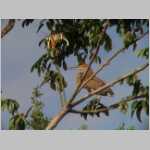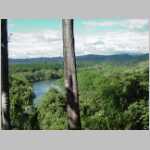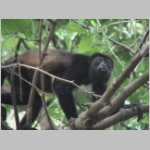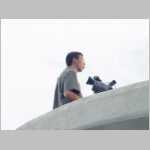2001/12/14 : Annular Eclipse
in Costa Rica
|
Thursday, December 6th,
08.30 AM. It rains on Roissy Charles de Gaulle Airport. We are leaving to the sunny
Florida. We feared the worst due to a French air traffic control strike. A
lot of flights are cancelled, but ours to Miami is maintained. We'll only
have 15 minutes delay. Great ! |
|||||
|
The most important
was to catch our connecting flight to Costa Rica where we planed to witness
the annular eclipse on December 14th. Security has been strictly
reinforced in US airports since the September 11th events. We'll
have around five controls but nobody claims. |
|||||
|
A final passport control and body
security check in the gangway and we board the American Airlines Airbus
A300/600. We leave Miami under a heavy rain. |
|||||
|
Two hours and a
half later, we land on Juan Santamaria Airport of San José, capital of Costa
Rica. It is raining here too. It is 07.30 PM, but 03.30 AM in Paris. We have
been travelling for more than seventeen hours and we really start to be
tired. We just need a good night of sleep. Tomorrow we have to wake up at
05.00 AM. |
|||||
|
It rained all night long.
At dawn the sun is brightly shining which suggests to be a great day. We
awoke refreshed and are very excited to leave to Tortuguero, North-East, on
the Caribbean coast. This is the only excursion we'll share with other
tourists. We are six couples seated in a minibus en route to Guacimo. |
|||||
|
Costa Rica is a
very small country: 50 700 km², just one tenth of France surface. Stuck
between Caribbean sea and Pacific ocean, Costa Rica is the country of active
volcanoes, rain forests, wild rivers and waterfalls. A large number of
natural parks shelter a luxuriant flora and fauna, and everywhere, coffee and
bananas plantations. |
|||||
|
In Costa Rica, you never
calculate distances in kilometres but in driving hours. We'll soon understand
why. Just after Guacimo village we drive a secondary road and we had to keep
the second gear during 50 km to reach the Tortuguero wharf. |
|||||
|
We suffered one
hour and a half, zigzagging to avoid hundreds of potholes. Tossed, bumped,
shacked, we lived a remake of the French movie "The Wages of Fear"
but this is our backs which were about to burst. We swapped our minibus for a
bottom flat boat, a "lancha". |
|||||
|
This is the only, but
very nice, way to reach Tortuguero. Tortuguero is a large tropical forest
national park. Its tangle marshes and narrow channels give Tortuguero a small
Amazonia appearance. This is a total disorientation. |
|||||
|
We navigate along
the Rio California main river, and we really do not know where to look at.
Great iguanas are resting on top of nearly 30 meters high trees. The harsh
cry of howling monkeys means we just invaded their territories. A frighten
bright red bird flies away in front of us. |
|||||
|
Large Montezuma birds nests
hang from branches. We meet hundreds of herons, egrets, green parrots, ibis,
eagles and colorful butterflies. Nearly one hour later we reach our hotel :
Laguna Lodge. The sky suddenly turned cloudy, and it starts to rain heavily. |
|||||
|
Tortuguero park is also
famous for its Leatherback and Green turtle nesting on the nearby sandy
beach. We missed the nesting season which occurs from July to October, but as
the hatching lasts sixty days, we have great chances to witness baby turtles
birthing. |
|||||
|
We for sure are on the Caribbean
cost, but beaches here are not as idyllic as in the West Indies. Quite rough
waves make them hazardous to swim or surf. Only turtles feel at ease.
Protected, they will be able to nest without being disturbed. |
|||||
|
Baby turtles are
always birthing after sunset. The baby turtle which broke its buried egg
feels a different temperature in the sand and it starts to climb to go up to
the surface. Some are so deeply buried in the sand they cannot reach the
surface by themselves. They need some little help and that is precisely what
happened to this little baby turtle. |
|||||
|
We only could see one, but what a
great emotion seeing this little turtle manage to try to find its way to the
sea. If it survives it will be back in around thirty years, on the same
beach, to nest. Good luck, little turtle, and take care of yourself… My God,
it's raining again ! |
|||||
|
It didn't rain but
poured all night long. The average rain falls here is 5000 mm annual. We woke
up at 5 AM to go on an early morning canoe birds watching excursion among the
narrow channels. The sky is brightly blue and the sun gives fantastic colours
to the nature. |
|||||
|
We leave the main river and enter
the small and narrow channels. We are in the heart of the forest. It is
impossible to say where the earth starts and where the water stops. This is
the kingfisher, herons, egrets, green parrots, sloths, spider monkeys,
howling monkeys, white head monkeys, iguanas and turtles kingdom. |
|||||
|
Flora is as
extravagant as fauna. Thirty meters high trees, coco trees, banana trees,
ficus, enormous philodendrons, orchids and all sorts of bromelias, hibiscus,
anthuriums and many many other tropical flowers. Branches and roots mix
together in this luxuriant thousand different green colours forest. |
|||||
|
It is time to go back for
breakfast. We'll return for a second excursion just after. Loud black clouds
magically covered the sky. The wind starts to blow and ripples the river
surface. We berth under a heavy rain. We can't see the facing shore. |
|||||
|
The rain doesn't
stop. Our guide prefers to defer our excursion after lunch. We gaze at the
now furious river carry large bunches of water lilies to the sea. The
underwear we washed yesterday didn't dry yet… |
|||||
|
It doesn't rain any more, but the
sky is totally overcast. We are back for the second visit among the narrow
channels .The motor is off, just drifting in the silence, we can easily watch
at the so magnificent birds. |
|||||
|
This young one
meter and a half long boa constrictor doesn't seem to be disturbed during its
nap. |
|||||
|
Extracted from Jurassic Park, this
dragon is able to walk and run on the water surface to escape from predators,
but this one doesn't seem to be frightened. It didn't even move an eye when
we approached. |
|||||
|
This, for true, is
a magic place. The channel becomes narrower and sometimes we have to bend our
heads to avoid branches and lianas. |
|||||
|
This little white head monkey
seems to be quite inquisitive. It shows a great interest in our expedition,
but it is greedier and soon goes back to delicious little yellow fruits. |
|||||
|
An extra gift.
These young red deers are quite rarely observed. That's what our guide said,
very suprised too. He found an explanation : the water level rose because of
the floods and the animals stay upper on the ground, which make them more
visible. The sun sets behind the clouds, it is time to go back to the hotel
before the night falls, and go on our way in Costa Rica. |
|||||
|
We woke very early this morning,
and the sun is brightly shining. We find back our flat boat to return to the
wharf and then Siqquires. Once on the place, we say goodbye to our travel
companions and get our hired car : a Dahaitsu 4X4. Our destination : Arenal
Volcano. Arenal was a quiet volcano till 1968 when it suddenly erupted due to
a violent earth quake. |
|||||
|
The volcano didn't
stop its activity and is very impressive at night. We were truly impatient to
contemplate its amazing fired top at night. We drove during five hours among
millions of potholes and under a pouring rain, and when we reached Arenal, it
was totally foggy. |
|||||
|
We'll know later ( and we had it
on good authority ) that Arenal is visible twice or third a year ! Here is
our own vision of Arenal. One little compensation, we heard it rumble and we
had a bath in the 35° water in the hotel swimming pool. This hot water comes
direct from the volcano hot natural springs. This was really great! |
|||||
|
We have to go on to
Rincon de la Vieja volcano, four hours drive from Arenal, close to Liberia.
We had to brave an important muddy landslide and the 4X4 was very efficient.
We'll rest during two days in a real hacienda located in another natural
park. Shortly after Arenal we find the sun back. |
|||||
|
The hacienda is located on the
volcano slope, twenty km far from Liberia, at the end of a secondary chaotic
road which doesn't allow us to drive faster than 30 km/h. We reach
Guachipelin Hacienda under a cloudy sky. Our backs seem to be broken. The
place is superb. Soon we have a horse back ride to the hot water and mud
springs. |
|||||
|
I won't be able to
sit down during two days, but what a ride, even under the rain. Later on, we
are able to witness a beautiful sunset over Pacific ocean. We are very
impatient to stay on the sunny desert beaches on the pacific coast. Coatis
are as familiar as pets, they can be found everywhere and are not easily
frightened. |
|||||
|
On the next rainy morning, we are
going for a walk in the natural park of Rincon de la Vieja. The volcano never
showed, its head always hidden in the clouds. On the way, we meet some
boiling mud and water ponds, and numbers of howling monkeys, coatis, and
noisy green parrots. |
|||||
|
The hacienda
prepared a giant BBQ for the tonight dinner and a typical band is playing
costarician music. Tomorrow, December 12th , we are leaving to the
sunny Nosara on the pacific coast, seven hours drive, via Liberia, Playa
Hermosa, Nicoya on Nicoya peninsula in Guanacaste province. |
|||||
|
Nosara is the driest place in
Costa Rica, that is why, Fred Espenak, alias Mr Eclipse, elected this village
to observe this annular eclipse on December 14th. The sun is back
as soon as we reach the pacific coast. It is very hot. Fifty km separate
Nicoya from Nosara and the road counts around ten potholes per Km²… |
|||||
|
It hasn't been
raining here in Nosara for two months and the trees in the neighbourhood are
covered with a thick dust, trucks and cars blow when driving on those dry and
damaged roads. |
|||||
|
Aahhh ! Nothing to do but rest
during four days. Go to the beach and swim in the warmy Pacific Ocean. Sun
bathe, and walk along these wonderful desert beaches. It will be paradise
like. Our hotel, Lagarta Lodge is a small Eden. It lays on the hill and
overviews the Pacific Ocean. What a sight ! |
|||||
|
I didn't hear
Jean-Paul wake up at dawn. He went for a walk in the small natural park down
the hill. He's just back for breakfast, muddy but delighted and made nice
shots and movie. The weather is very fine. We decide to go to the beach and
try to locate the best place to observe the eclipse tomorrow. |
|||||
|
Watching the eclipse from
the hotel would be the easiest option, only one detail made us change our
minds : the sun will be partially hidden by high trees from the first contact
till annularity. |
|||||
|
The beach could be
another good option, but it will be high tide tomorrow during the eclipse,
with perhaps a lot of people gathered on the beach. |
|||||
|
We wish to say "hello"
to fred Espenak at his hotel, but he didn't arrive yet in Nosara. No problem,
we'll have plenty of time tomorrow morning. A lot of astronomers ( amateur or
pros from all around the world ) have arrived in Nosara. They all wear an
eclipse T-shirt : Hawaii 1991, Brazil 1994, Costa Rica (yes, yes ) 1998, and
of course Zambia or Zimbabwe 2001. |
|||||
|
One of them tells
us than the "Blue Marlin" restaurant, a little bit further, is
selling T-shirts commemorating this annular eclipse. We rush and buy ours. |
|||||
|
Then we leave to Ostional beach,
eight km far. It will take us nearly forty minutes to reach the place and
we'll have to ford three small rivers… Ostional beach is famous for its all
year long Green turtles nesting. The beach is covered with millions of broken
ping pong balls like eggs. We decide to come back at night and perhaps have
the chance to see some green turtles nest. |
|||||
|
One cold "Impérial"
(nice local beer) is relaxing sipped in the swimming pool at sun set. The
view from the hotel is really great. We can hear some howling monkeys down in
the park. Sun set is fabulous. How nice the life is. |
|||||
|
Two of other hotel guests decide
to join us for the trip to Ostional tonight. We arrive at 9 PM. A ranger who
works for the turtles protection welcomes us on the beach. Two big green
turtles of over 200 kg are spotted nearby. He points his electric torch in
their direction but carefully avoid to aim their eyes. |
|||||
|
The night is so
dark we can't see each other. We come close to the first exhausted turtle
which crawls to reach the dry sand. We never saw so many stars in the sky.
Today is the peak of Geminid's meteor shower and dozen of brilliant shooting
stars light up the sky. This is a magic, grandiose, touching moment. |
|||||
|
We spot each other just by
listening to our voices. Jean Paul is laying down and films the turtle with
his infra red camera. The turtle seems to cry and slowly goes on to its
release. The exhausted second one starts to dig its nest on the very shore.
The worst will happen later on. At dawn when the turtles return into the
ocean, their nests will be systematically destroyed. |
|||||
|
It seems turtle
eggs have the magic power to reinforce men virility, then the nearby village
inhabitants come on the beach to rob the eggs they will sell a good price.
Turtles are protected everywhere in Costa Rica, except at Ostional,
universally known as a famous place for nesting. Ecologists are vainly trying
to fight against this lucrative robbery. |
|||||
|
Friday December 14th.
Today is the eclipse day. The small Nosara village will be for a couple of
hours the centre of the astronomical world. |
|||||
|
Just after
breakfast Jean Paul and I are preparing our equipments. Same ones as for our
last eclipse observation in Zimbabwe. We only brought digital cameras,
filters, tele extenders and micrometric mounts on tripods. Everything seems
to work normally. The weather is fine. Everything looks good. |
|||||
|
It is time to go downtown. A Swiss
TV reporter is coming with us. He wishes to make an eclipse report with two
amateur astronomers : Jean Paul and I ! This report is supposed to run on the
German French ARTE broadcast. We need to go to the post office. I have some
home made eclipse covers to be cancelled on the eclipse day. |
|||||
|
Costa Rica didn't
issue a special eclipse stamp as they did in 1992, but as a eclipse stamps
collectors, we'll have a nice philatelic souvenir of this day. Back on the
main street, it seems clouds circle the top of the nearby mountains , and…
yes, for sure, they are drifted in our direction. |
|||||
|
"Blue Marlin" restaurant
( where we bought our T-shirts yesterday ) is extremely busy. Our reporter
wants to buy a T-shirt too. They are showing on a big table : T-shirts,
eclipse viewers, eclipse cans coolers, and of course, hundreds of
"Imperial" cans. People will be thirsty this afternoon in Nosara. |
|||||
|
Fred Espenak and
his group arrived yesterday evening. We meet him at his hotel when he was
just about to leave for his observation site, the Nosara Beach Hotel, a
constant under construction hotel, over viewing the Nosara beach. |
|||||
|
Still escorted by our reporter and
his camera, we follow Fred Espenak and his team. The Costarician TV is on the
place too and cameramen set their equipment. The scientific
"Cientec" Costarician foundation has come too. The sky is fully
cloudy. |
|||||
|
We ask the
Costarician TV reporters if the place is a private observation site. As they
say it isn't, we decide to stay here too to observe the eclipse. |
|||||
|
We can't believe customers are
staying in this hotel. Everything is under construction. Men at work are
building a kind of minaret which gives this hotel a future sect temple
looking… The minaret has been allocated to Fred and his team. |
|||||
|
We have to pay
attention where we are stepping. The stairs are not finished and the steps
are irregular. Metallic frames are emerging from everywhere, and many cables
dangerously lie down on the floor. |
|||||
|
Everyone is carefully setting his
equipment. The sky turns more and more cloudy. |
|||||
|
Fred looks nervous. |
|||||
|
We are staying on a cupola close
to Fred's minaret. We have to be very cautious cause there is no hand rail to
protect us from a possible 10m fall down. |
|||||
|
You just need a
compass to confirm that the sun will precisely set at 245°, in this exact
direction. |
|||||
|
Can't be true ! Rain drops start
falling. We dash to protect our cameras under a plastic bag. We missed the
first contact. Nevertheless it seems a small blue hole appears in the grey
sky… |
|||||
|
The small blue hole
turns larger and larger, and then the sun finally appears. Everybody is
shouting. |
|||||
|
Kids start to wear their eclipse
glasses. |
|||||
|
Here it is ! We at
last spotted the sun in our lenses. |
|||||
|
First picture… |
|||||
|
Second picture… |
|||||
|
Ugh, nice green one ! This is due
to the solder glass filter on Jean Paul's camera. |
|||||
|
Two more pictures
and the clouds win over the blue hole ! The sky returns totally overcast. It
lasted two minutes and a half. Finished, over, terminado… Heavy rain drops
start to fall again. |
|||||
|
The clouds turn darker and darker.
It hasn't been raining in Nosara for two months, then WHY today ? |
|||||
|
All telescopes are
now protected with plastic bags. |
|||||
|
From time to time a clear sky hole
is breaking the clouds, but it never breaks at the right place. |
|||||
|
Fred is giving up.
No, there will be no improvement. |
|||||
|
This is a total dismay… |
|||||
|
Fred's team just
beneath our cupola, doesn't trust any more. |
|||||
|
Frankly, nobody doesn't trust
anymore. |
|||||
|
Anyway, the show
must go on… |
|||||
|
But the spirit is truly low. |
|||||
|
Costarician TV is
resignated too. |
|||||
|
Here is Fred's equipment. Quite
clever his counterweight system… and what a gain of space in the suitcase. |
|||||
|
Life is cruel Fred,
isn't it ? |
|||||
|
It must be so beautiful, up there,
over the clouds… |
|||||
|
No, it is so
stupid. |
|||||
|
What a disappointment ! |
|||||
|
The Costarician TV
reporter, on live broadcast, tells the Costarician Tv watchers they won't see
the eclipse. |
|||||
|
Totality will occur in a few
seconds. The show is ruined. Colours are changing. The clouds turn lead like.
|
|||||
|
This is now
totality ! We just imagine the beauty of the phenomenon over heads. |
|||||
|
It must be superb
up there… |
|||||
|
The sky is suddenly breaking over
our heads, but it is no use now. The western horizon remains totally cloudy.
We patienyly wait till the end of the eclipse but we know no miracle will
happen. |
|||||
|
Reporters from the Costarician
newspaper LA NACION didn't succeed to get better pictures than us. Here are
their pictures taken in Nosara and Libéria, north of the country. They will
be printed on the main page of the newspaper. |
|||||
|
But some people are very lucky. Olivier
"Klipsi" Staiger and Vic Winter decided to observe the
eclipse from Punta Leona, south of Costa Rica, close to Jaco City. For sure
the weather was cloudy too, but he is the only one who could observe and make
some nice pictures of all the phases of this eclipse. Thanks Klipsi and Vic .
http://eclipse.span.ch/ http://www.icstars.com |
|||||
|
Photos by Olivier "Klipsi" Staiger And Vic Winter |
|||||
|
It is time now to leave Costa
Rica. On our way back to San José we crossed the Taracoles river, located in
the Carara natural Park. The river is known for its crocodiles. The are quite
big. A lot of ibis and egrets are the only ones able to approach them, and
they do not seem to be scared. Tomorrow we are returning to Paris. |
|||||
|
The sun is shining
in San José. Tonight the whole town celebrates the Light Festival with
fireworks and firecrackers. All the children wear Santa Claus' hat. This
festival just before Xmas looks like a carnival with its parades and fancy
dressings. Bye bye Costa Rica. Rendez-vous on 2002 june 10th.
In the sunny Mexico for the
next annular eclipse. |
|||||
© 2001 Martine TLOUZEAU et Jean-Paul GODARD. Tous droits réservés
ème visiteur de
l'Uranoscope.
ème visiteur de
MsEclipse.

























































































































